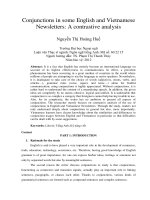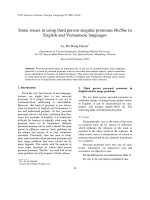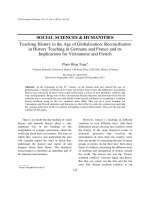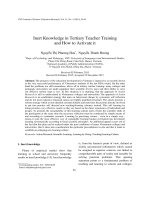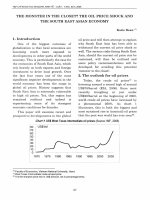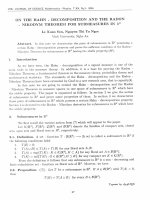DSpace at VNU: Mother image in English and Vietnamese songs – A literary analysis using transitivity system in Systemic Functional Linguistics perspective
Bạn đang xem bản rút gọn của tài liệu. Xem và tải ngay bản đầy đủ của tài liệu tại đây (234.35 KB, 10 trang )
VIETNAM NATIONAL UNIVERSITY, HANOI
UNIVERSITY OF LANGUAGES AND INTERNATIONAL STUDIES
FACULTY OF POST-GRADUATE STUDIES
TẠ THỊ THU HẰNG
MOTHER IMAGE IN ENGLISH AND VIETNAMESE
SONGS – A LITERARY ANALYSIS USING TRANSITIVITY
SYSTEM IN SYSTEMIC FUNCTIONAL LINGUISTICS
PERSPECTIVE
(Hình tượng người mẹ trong các bài hát tiếng Anh và tiếng Việt – một phân
tích văn học theo hệ thống chuyển tác trong ngôn ngữ chức năng hệ thống)
M.A. COMBINED PROGRAMME THESIS
Major: English Linguistics
Code: 60220201
Hanoi - 2016
VIETNAM NATIONAL UNIVERSITY, HANOI
UNIVERSITY OF LANGUAGES AND INTERNATIONAL STUDIES
FACULTY OF POST-GRADUATE STUDIES
TẠ THỊ THU HẰNG
MOTHER IMAGE IN ENGLISH AND VIETNAMESE
SONGS – A LITERARY ANALYSIS USING TRANSITIVITY
SYSTEM IN SYSTEMIC FUNCTIONAL LINGUISTICS
PERSPECTIVE
(Hình tượng người mẹ trong các bài hát tiếng Anh và tiếng Việt – một phân
tích văn học theo hệ thống chuyển tác trong ngôn ngữ chức năng hệ thống)
M.A. COMBINED PROGRAMME THESIS
Major: English Linguistics
Code: 60220201
Supervisor: Assoc. Prof. Dr. Lâm Quang Đông
Hanoi – 2016
DECLARATION
I declare that this MA thesis, entitled Mother image in English and
Vietnamese songs – A literary analysis using transitivity system in Systemic
Functional Linguistics perspective, is entirely the result of my own work. The
thesis contains no material which has been accepted for the award of any
other degree or diploma in any university or tertiary institution, and to the best
of my knowledge, neither does it contain material previously published or
written by another person, except where due acknowledgement is made in the
text.
Hanoi, 2016
Tạ Thị Thu Hằng
1
ACKNOWLEGEMENTS
First and foremost, I would like to express my deepest gratitude to my
supervisor, Assoc.Prof.Dr Lâm Quang Đông for transferring me his
specialized knowledge, his inspiring me the love in linguistics as well as his
valuable suggestions, advice and correction throughout my study.
I also take this opportunity to thank all my lecturers in the Faculty of
Post-Graduate Studies at University of Languages and International Studies,
Vietnam National University, Hanoi for their interesting lectures, which have
surely contributed to the foundation of my thesis.
Finally, I would like to show my deep gratitude to my family for their
support, encouragement and understanding, without which my theis would
not have been accomplished.
Hanoi, January, 2016
Ta Thi Thu Hang
2
ABSTRACT
Song lyrics and rhymes serve as an important part of English teaching
curricula in a variety of countries. Of all topics, songs about mother have
drawn attraction of listeners and learners as they not only entertain people but
also educate them in terms of linguistic knowledge and moral values. Until
now, there has not been much research on mother image under the light of
linguistics. These provide me with the motivation to carry out the research
“Mother image in English and Vietnamese songs – A literary analysis using
transitivity system in Systemic Functional Linguistics perspective”. The study
is conducted to figure out the similarities and differences in the way mother
image is represented in English and Vietnamese in view of systemic linguistic
perspective. In other words, the study aims to give readers a brief description
and analysis of mother image in English and Vietnamese songs. Within the
framework of an M.A. thesis, the research cannot cover all aspects of mother
image in English and Vietnamese; we therefore limit it to a manageable
scope: analyzing mother image in songs in terms of transitivity system. Two
principal methods employed in the study are descriptive and comparative
analysis. Through descriptive method, six types of transitivity process in each
language were identified. In fulfilling the focuses of the study, comparative
method is applied to the identification of prominent features of mother image
in English and Vietnamese songs. The paper also provides conclusions on the
images to which mother is compared, and these images are closely associated
with cultural and historical factors. Insights gained through this study lend
themselves to suggestions for designing exercises based on songs for teaching
English as well as linguistic theory.
3
CHAPTER I: LITERATURE REVIEW
1.1.
SYSTEMIC FUNCTIONAL LINGUISTICS
1.1.1. Development of Systemic Functional Linguistics
Systemic Functional Linguistics or Grammar, a grammar model developed by
Michael Halliday in the 1960s, refers to a new approach to the study of
grammar.
Systemic linguistics deals with the way spoken and written
language operating in different social situations. In particular, it is very useful
in illustrating three points: the operation of text beyond the level of the
sentence, the difference in structuring the text and the variable changes of the
language to meet the purpose of the users. It takes on descriptive approach
and focuses on groups of words that function to make meanings. In his book,
An Introduction to Functional Grammar, Halliday (1994) points out that
functional grammar is so-called because its conceptual framework is a
functional one rather than a formal one. Such functions are identified in three
distinct senses, in its interpretation of texts, of the system, and of the elements
of linguistic structures. In the relation to the first aspect, functional grammar
is involved in how the language is used. In other words, each text unfolds in a
different usage of context. Regarding the second point, the fundamental
components of meaning in language are functional components. Based on the
analysis of Halliday, all languages possess two main types of meanings, the
“ideational” (to understand the environment), and the “interpersonal” (to act
on the others in it). The third meaning is formed by the combination of these
two above, the “textual”. Three components are called metafunctions in the
terminology of FG theory. In the third sense, each element in a language is
4
explained by reference to its function in the total linguistic system.
Accordingly, “a functional grammar is one that construes all the units of a
language– its clauses, phrases and so on. Specifically, each part is
interpreted as functional with respect to the whole” (Halliday, 1994).
Following the pioneering model initiated by Halliday, some of other linguists
developed and gave informal explanation of functional grammar. Thompson
(1996) describes the three metafunctions of functional grammar as follows.
Firstly, we use language to talk about our experience of the world, including
the world in our minds, to describe events, states and the entities involved in
them. Secondly, we also use the language to interact with other people, to
establish and maintain relation with them, to influence their behavior, to
express our own viewpoint on things in the world, and to elicit or change
theirs. Finally, in using language, we organize our messages in ways which
indicate how they fit in with the other messages around them and with the
wider context in which we are talking or writing.
Similarly, Martin, Matthiessen and Painter (1997) define functional grammar
as a way of looking at grammar in terms of how grammar is used. In the field
of linguistics, formal grammar, which is an alternative to functional grammar,
is concerned with the way our genes constrain the shape of our grammar, and
thus constrain what a person can and cannot say.
Therefore, functional grammar, based on cultural and social contexts, is
considered as an effective tool for the description and evaluation of how
language can be adopted to write and speak more appropriately and
powerfully. Thanks to functional grammar, to some extent, our ability of
REFERENCE
5
In English
1. Brad
Shaw.
(1998).
Figures
of
speech.
Retrieved
from
/>2. Gardner, H. (1983). Music intelligence. Harward University: USA.
3. Gerot, L. & Wignell, P. (1994). Making Sense of Functional Grammar.
Antipodean Educational Enterprises: Sydney.
4. Halliday, M.A.K. & Matthiessen, C. M. I. M. (2004). An Introduction
to Functional Grammar. London E. Arnold.
5. Halliday, M.A.K. & Matthiessen. (1994) . Introduction to functional
grammar (2nd ed.). London E.Arnold.
6. Halliday, M.A.K. (1994). An introduction of functional grammar.
London E. Arnold.
7. Kaplan, R.B. (1966). Cultural thought patterns in Inter-cultural
education. Blackwell Publishers.
8. Lakoff & Johnson (1920). Metaphor we live by. John Benjamins.
9. Leech.N.L. (1969). A linguistic Guide to English Poetry. London:
Longman ltd.
10.Nunan, D. (1992). Introducing Discourse Analysis. Penguin: London
11.Saeed. (2003). Semantics. Blackwell publisher.
12.Swales, J. (1990). Genre analysis. English in academic and research
settings. Cambridge: Cambridge University Press.
13.Teng. Y. C. (2013). Analysis of songs and rhymes in children English
text
books.
Retrieved
from
www.naer.edu.tw/ezfiles/0/1000/img/18/100-09.pdf
14. Thompson, G (1996). Introducing Functional Grammar. New York,
NY: ST.Martin’s Press, Inc.
6
15.Yang Liu. (2015). East meets West. Taschen America Llc.
In Vietnamese
16.Cù Đình Tú. (1953). Phong cách học và đặc điểm từ vựng Tiếng Việt.
NXB Đại học và Trung học chuyên nghiệp: Hà Nội.
17.Hoàng Văn Vân (2005). Ngữ pháp kinh nghiệm của cú tiếng Việt: Mô
tả theo quan điểm chức năng hệ thống. Science and Society Publishing
house.
18.Nguyễn Hòa (2004). Understanding English semantics. VNU
Publishing house.
19.Võ Đại Quang (2005). Semantics. The culture and information
Publishing house.
7
I


